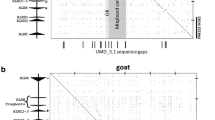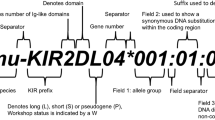Abstract
Natural killer cell responses are controlled to a large extent by the interaction of an array of inhibitory and activating receptors with their ligands. The mostly nonpolymorphic CD94/NKG2 receptors in both humans and mice were shown to recognize a single nonclassical MHC class I molecule in each case. In this paper, we describe the CD94/NKG2 gene family in cattle. NKG2 and CD94 sequences were amplified from cDNA derived from four animals. Four CD94 sequences, ten NKG2A, and three NKG2C sequences were identified in total. In contrast to human, we show that cattle have multiple distinct NKG2A genes, some of which show minor allelic variation. All of the sequences designated NKG2A have two tyrosine-based inhibitory motifs in the cytoplasmic domain and one putative gene has, in addition, a charged residue in the transmembrane domain. NKG2C appears to be essentially monomorphic in cattle. All of the NKG2A sequences are similar apart from NKG2A-01, which, in contrast, shares the majority of its carbohydrate recognition domain with NKG2-C. Most of the genes appear to generate multiple alternatively spliced forms. These findings suggest that the CD94/NKG2A heterodimers in cattle, in contrast to other species, are binding several different ligands. Because NKG2C is not polymorphic, this raises questions as to the combined functional capacity of the CD94/NKG2 gene families in cattle.



Similar content being viewed by others
References
Araibi EH, Marchetti B, Dornan ES, Ashrafi GH, Dobromylskyj M, Ellis SA, Campo MS (2006) The E5 oncoprotein of BPV-4 does not interfere with the biosynthetic pathway of non-classical MHC class I. Virology 353:174–183
Birch J, Murphy L, MacHugh ND, Ellis SA (2006) Generation and maintenance of diversity in the cattle MHC class I region. Immunogenetics 58:670–679
Braud VE, Allan DS, O’Callaghan CA, Soderstrom K, D’Andrea A, Ogg GS, Lazetic S, Young NT, Bell JI, Phillips JH, Lanier LL, McMichael AJ (1998) HLA-E binds to NK cell receptors CD94/NKG2A, B and C. Nature 391:795–799
Davies CJ, Eldridge JA, Fisher PJ, Schlafer DH (2006) Evidence for expression of both classical and non-classical major histocompatibility complex class I genes in bovine trophoblast cells. Am J Reprod Immunol 55:188–200
Ellis SA, Holmes EC, Staines KA, Smith KB, Stear MJ, McKeever DJ, MacHugh ND, Morrison WI (1999) Variation in the number of expressed MHC genes in different cattle class I haplotypes. Immunogenetics 50:319–328
Gagnier L, Wilhelm BT, Mager DL (2003) Ly49 genes in non-rodent mammals. Immunogenetics 55:109–115
Gonzalez S, Groh V, Spies T (2006) Immunobiology of human NKG2D and its ligands. Curr Top Microbiol Immunol 298:121–138
Gunturi G, Berg RE, Forman J (2004) The role of CD94/NKG2 in innate and adaptive immunity. Immunol Res 30:29–34
Hao L, Klein J, Nei M (2006) Heterogeneous but conserved NK receptor gene complexes in four major orders of mammals. Proc Natl Acad Sci USA 103(9):3192–3197
Kabat J, Borrego F, Brooks A, Coligan JE (2002) Role that each NKG2A ITIM plays in mediating the human CD94/NKG2A inhibitory signal. J Immunol 169:1948–1958
Kikuchi-Maki A, Catina TL, Campbell KS (2005) KIR2DL4 transduces signals into human NK cells through association with the Fc receptor gamma protein. J Immunol 174:3859–3863
Kim DK, Kabat J, Borrego F, Sanni TB, You CH, Coligan JE (2004) Human NKG2F is expressed and can associate with DAP12. Mol Immunol 41:53–62
LaBonte ML, Choi EI, Letvin NL (2004) Molecular determinants regulating the pairing of NKG2 molecules with CD94 for cell surface heterodimer expression. J Immunol 172:6902–6912
Lanier LL, Corliss B, Wu J, Phillips JH (1998) Association of DAP12 with activating CD94/NKG2C NK cell receptors. Immunity 8:693–701
Li P, Morris DL, Willcox BE, Steinle A, Spies T, Strong RK (2001) Complex structure of the activating immunoreceptor NKG2D and its MHC class I-like ligand MICA. Nat Immunol 2:443–451
Lieto LD, Maasho K, West D, Borrego F, Coligan JE (2006) The human CD94 gene encodes multiple, expressible transcripts including a new partner of NKG2A/B. Genes Immun 7:36–43
Llano M, Lee N, Navarro F, Garcia P, Albar JP, Geraghty DE, Lopez-Botet M (1998) HLA-E-bound peptides influence recognition by inhibitory and triggering CD94/NKG2 receptors: preferential response to an HLA-G-derived monomer. Eur J Immunol 28:2854–2863
Lohwasser S, Wilhelm B, Mager DL, Takei F (2000) The genomic organization of the mouse CD94 C-type lectin gene. Eur J Immunogenet 27:149–151
MacFarlane AW, Campbell KS (2006) Signal transduction in NK cells. Curr Top Microbiol Immunol 298:23–57
McQueen KL, Wilhelm BT, Harden KD, Mager DL (2002) Evolution of NK receptors: a single Ly49 and multiple KIR genes in the cow. Eur J Immunol 32:810–817
Miller JD, Weber DA, Ibegbu C, Pohl J, Altman JD, Jensen PE (2003) Analysis of HLA-E peptide-binding specificity and contact residues in bound peptide required for recognition by CD94/NKG2. J Immunol 171:1369–1375
O’Callaghan CA, Tormo J, Willcox BE, Braud VM, Jakobsen BK, Stuart DI, McMichael AJ, Bell JI, Jones EY (1998) Structural features impose tight peptide binding specificity in the non-classical MHC molecule HLA-E. Mol Cell 1(4):531–541
Raulet DH, Held W, Correa I, Dorfman JR, Wu MF, Corral L (1997) Specificity, tolerance and developmental regulation of NK cells defined by expression of class I-specific Ly49 receptors. Immunol Rev 155:41–52
Shum BP, Flodin LR, Muir DG, Rajalingam R, Khakoo SI, Cleland S, Guethlein LA, Uhrberg M, Parham P (2002) Conservation and variation in human and common chimpanzee CD94 and NKG2 genes. J Immunol 168:240–252
Storset AK, Slettedal IO, Williams JL, Law A, Dissen E (2003) NK cell receptors in cattle: a bovine KIR-like receptor multigene family contains members with divergent signalling motifs. Eur J Immunol 33:980–990
Trowsdale J (2001) Genetic and functional relationships between MHC and NK receptor genes. Immunity 15:363–374
Vance RE, Tanamachi DM, Hanke T, Raulet DH (1997) Cloning of a mouse homolog of CD94 extends the family of C-type lectins on murine NK cells. Eur J Immunol 27:3236–3241
Vance RE, Jamieson RM, Raulet DH (2002) Recognition of the class Ib molecule Qa-1(b) by putative activating receptors CD94/NKG2C and CD94/NKG2E on mouse NK cells. J Exp Med 190:1801–1812
Vilches C, Parham P (2002) KIR: diverse, rapidly evolving receptors of innate and adaptive immunity. Annu Rev Immunol 20:217–251
Wada H, Matsomoto N, Maenaka K, Suzuki K, Yamamoto K (2004) The inhibitory NK cell receptor CD94/NKG2A and the activating receptor CD94/NKG2C bind the top of HLA-E through mostly shared but partly distinct sets of HLA-E residues. Eur J Immunol 34:81–90
Acknowledgements
This work was supported by the Biotechnology and Biological Sciences Research Council, UK. We would like to thank the staff of the IAH farm for maintenance of MHC inbred animals and Helen Prentice for help with sampling. The experiments carried out in this study comply with UK law.
Author information
Authors and Affiliations
Corresponding author
Rights and permissions
About this article
Cite this article
Birch, J., Ellis, S.A. Complexity in the cattle CD94/NKG2 gene families. Immunogenetics 59, 273–280 (2007). https://doi.org/10.1007/s00251-006-0189-z
Received:
Accepted:
Published:
Issue Date:
DOI: https://doi.org/10.1007/s00251-006-0189-z




